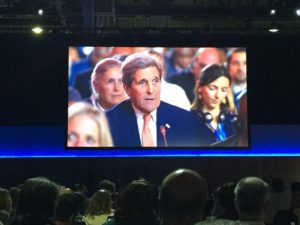We have much more to do and your continued support is needed now more than ever.
Our Call for an Ambitious Global Climate Agreement Has Been Answered
On Saturday, we witnessed history being made as high-level representatives from nearly 200 countries at the United Nations Climate Conference (COP21) approved a monumental agreement to curb climate change. The “Paris Agreement” is the first comprehensive agreement to limit carbon pollution that applies to all countries, and seeks to limit global warming to 1.5 degrees Celsius – a target that could avoid the worst impacts of climate change for people and wildlife.

![]()
Speak out for wildlife! Ask how Congress will build on the new Paris Agreement.
The Paris Agreement will take effect in 2020, when the Kyoto Protocol’s second commitment period expires, and many countries’ new obligations kick in (for example, in the U.S., our commitment centers around the Clean Power Plan). In the intervening five years, countries are encouraged to ramp up their actions at home.
The National Wildlife Federation was in Paris working hard to ensure that the Agreement was ambitious, rigorous, and transparent. For that to occur, the Agreement had to highlight the important role of the land sector (agriculture, forestry, and land-use change like deforestation).
Why the Agreement Needed to Address Deforestation

But forests and agriculture also have great potential to be a part of the solution due to plants’ unique ability to store or “sequester” carbon which involves removing carbon from the atmosphere and storing it in roots, trunks, branches, and leaves. Existing forests must be left standing; and where they have already been cleared, they should be replanted.
In short, the long term goal of the agreement would not be reachable without tapping into the “great green carbon sink” – our forests.
An important feature of the Agreement that the National Wildlife Federation fought to preserve is the explicit recognition of the role that tropical forests play in reducing climate pollution because of the immense amount of carbon they can hold. Forests and deforestation are so important to reaching our shared goal that they were referenced in the Agreement and the United Nations’ Decision to adopt it eleven times (other sectors were rarely, if ever specifically named).
Article 5 of the Paris Climate Agreement calls on governments to take action to conserve and enhance forests, and explicitly recognizes “REDD+” (Reducing Emissions from Deforestation and Forest Degradation, and the “+” referring to the role of conservation, sustainable management of forests and enhancement of forest carbon stocks) – a package of previous United Nations decisions designed to incentivize developing countries to leave forests standing. The inclusion of REDD+ in the Agreement provides a powerful political and economic signal that forests need to remain a part of the solution. Ceasing deforestation and restoring forests has the potential to contribute over one third of the potential emissions reductions we need by 2030.

NWF encourages governments to ramp up financing for REDD+ before and after 2020, and for the private sector – producers of commodities like palm oil, soy, beef and leather, international traders, manufacturers, and retailers – to put private capital to good use and to fully implement zero-deforestation commitments.
Though the Paris Agreement charts the course to a world limited to 1.5°C increase in temperature, we still need to walk the walk to get there. The set of commitments agreed in Paris still need to be implemented. Even if they are implemented fully, they simply won’t get us there alone. They will need to be strengthened over time, with additional actions taken, including putting a price on carbon.
Moreover, additional finance is needed for spurring clean energy and adaptation in developing countries – to safeguard people and wildlife from the unavoidable impacts of climate change. Fortunately, the Agreement keeps all Parties committed to revising and improving their commitments every five years.
The pieces are now in place. It’s up to all of us to act – to insist that all nations move forward with implementation and ramp up their ambition – including through the conservation of forests that are so vital to climate, livelihoods, and wildlife.
When Senators and Representatives are home this holiday season, they should hear from you. Send a message to remind Congress that addressing climate change is a priority for wildlife and for our American outdoor heritage!
Read the National Wildlife Federation’s President and CEO, Collin O’Mara’s statement on the Paris Agreement here.






















